
Welcome to Santiago -- Cuba's second largest city. The chaotic streets hum with the sounds of bustling
crowds and busy commerce. Cargo ships constantly arrive and depart from the port. Demand is continuous,
if unpredictable, for a supply of local products such as exotic fruits, sugar, rum, tobacco, and cigars. Your
business card says “broker”, but in reality you're a shady wheeler-dealer who arranges deals with the locals
and with corruptible officials to move goods and meet the demand of those ever-present cargo ships. Your
ability to procure these goods is only as reliable as your “connections”. If you are the best at seizing the
ever-changing opportunities that arise and if you invest your limited money more wisely than your fellow
brokers, you'll win. Supply and demand for goods is constantly changing, as are the locals and their locations.
Each time you play you will face new tactical challenges in the vibrant Caribbean world that is Santiago
de Cuba.
The following rule changes apply here on yucata.de:
- In the online version, all victory points, goods and the money of each player are visible for everyone.
Object of the game
The object of the game is to collect the most victory points. You get victory points by delivering
goods to the ships, by using different buildings, or by visiting the dancer.
Components
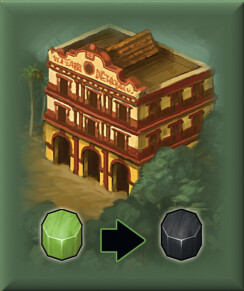 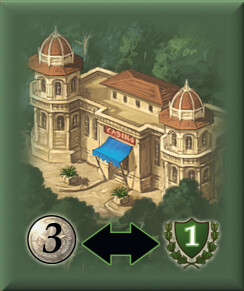  |
12 building tiles |
  |
9 Cuban tiles |
 |
60 victory point markers (online only total value shown) |
    |
4 playing pieces |
each 3x     |
12 property markers |
     |
5 six-sided special dice |
|
 |
36 coins (pesos) |
 |
1 car |
 |
1 ship token |
 |
1 value marker |
 |
8x wood (total: 48 goods) |
 |
8x sugar cane |
 |
8x citrus fruit |
 |
8x tobacco |
 |
8x rum |
 |
8x cigar |
|
Setup
Each player chooses a color and receives a playing piece and 3 property markers.
He also receives a starting capital of 3 pesos and 2 victory points.
Furthermore, each player gets 1 sugar cane (white), 1 tobacco (green)
and 1 citrus fruit (orange).
The 12 building tiles and the 9 Cuban tiles are placed randomly
on the corresponding places. The car, the ship token and the
value marker are put on the starting positions.
The player to the right of the starting player takes the 5 dice and rolls them. Then he chooses 4 of
the 5 dice and places them, as they were rolled onto the 4 die spaces of the large ship.
The dice represent the current ship’s demand for
goods. The color of each die matches the respective good.
Put the remaining die next to the game board.
(This good will not be in demand, no matter what number it shows.)
 |
Each die has one side
with a “0“ (no demand), two sides with a demand of “1“, two sides with a demand of “2“ and one
side that shows the highest demand of “3“. The exception is the orange die. It shows a “4“
instead of the second “1“. |
A street runs in front of the Cuban tiles. A car (used by all players) drives along this
street in clockwise direction. The street has 10 stops: Each white star belongs to the adjacent Cuban.
The yellow star belongs to the port.
Important: The street is a loop. The next stop after the port
is always the white star on the left with the arrow.
Playing the game
Beginning with the starting player, players take turns in clockwise player order.
Each turn consists of two elements:
| A. |
|
B. |
|
Go by car to a Cuban or to the port |
|
Use a building with your playing piece |
When it is your turn, you must move the car in a clockwise direction.
You may move it any number of “star“ spaces along the street. But only the first step to the next space is free.
Each step beyond the first space costs 1 peso each.
If you stop in front of a Cuban, you usually get goods, victory points, or money.
In the port you trigger a general delivery round instead. |
|
After you go to a Cuban by car, you must move your playing piece to a building.
The color of the flower on the Cuban tile shows which 3 buildings you can choose from.
Buildings that are occupied by another playing piece cannot be visited.
You may then use the function of that building.
If you go to the port by car, you cannot use any building. |
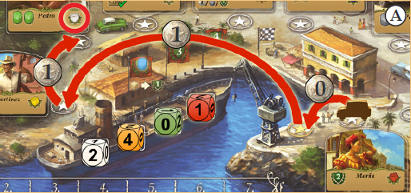 |
|
Example:
A) Martina goes by car from “Maria“ to “Pedro“.
So she must pay 2 pesos.
B) The “Pedro” tile white flower indicates that Martina must now move her
playing piece to a building beneath a white flower.
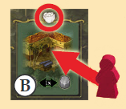 |
A. Go by car to a Cuban or to the port
If you stop the car at a Cuban, you may immediately use his/her function.
 |
Pedro - the tobacco merchant
You get 2 tobacco from the supply. |
 |
José - the sugar cane farmer
You get 2 sugar cane from the supply. |
 |
Conchita - the fruit merchant
You get 2 citrus fruits from the supply. |
 |
Miguel - the lumberjack
You get 2 wood from the supply. |
 |
Pablo - the fence
You get 1 good of your choice from the supply. |
|
 |
Maria - the dancer
You get 2 victory points from the supply. |
 |
Martinez - the musician
You get 3 pesos from the supply. |
 |
El Zorro - the pickpocket
Each of the other players must give you one of the following (of their choice):
1 peso
OR 1 of any good (except wood)
OR 1 victory point
The flower on the “El Zorro“ tile is transparent. After going to “El Zorro“ by car, you do not
move your playing piece to another building. Instead, your playing piece remains in place and you may use the
function of that building again. If you go to “El Zorro“ during the very first round, you cannot use any building.
|
|
Note: Goods are limited. There are only 8 of each good. If the supply is out of the good you would normally receive, then you go away empty-handed.
 |
Alonso - the lawyer
You may choose one of two options: |
 |
1. You may seize one building of your choice (that does not yet belong to a player)
by putting one of your property markers in the upper left corner of the selected
building. (Each player may seize a maximum of three buildings during the game.)
OR
2. You may use the function of a building that you already own (i.e., on which you have a
property marker). It does not matter if the building is currently occupied by another player.
Example: Martina goes to the lawyer by car. Instead of seizing another building, she uses the bank that
she seized on an earlier visit. That gives her 2 pesos. Since the flower on the lawyer tile is white, she must
now visit a building beneath a white flower as usual and may use that building’s function as well.
In addition, you get 1 victory point from the supply each time another
player visits a building that you own (see “Use a building with your playing piece“).
Port
|
If you stop the car at the port, you instantly trigger a delivery round, during which all
players may deliver goods to the ship.
Starting with yourself and then continuing in clockwise Delivery round player order, each player
may deliver one kind of good (but never more than the ship currently demands).
Return the delivered goods to the supply.
After each delivery, adjust the current demand by reducing the corresponding die value in the port
by the delivered amount.
Anyone who delivers goods to the ship immediately receives victory points. Depending on the position
of the blue value marker on the flags, each unit is worth 2, 3, or 4 victory points.
Anyone who does not want to deliver or is not able to deliver any goods must pass.
This player is not allowed to re-enter the ongoing delivery round later.
Once the demand is met for all goods (all dice show a “0“),
the delivery round ends. The ship departs and a new ship comes into port (see “A new ship“).
The delivery round ends as well, if all players have passed and the demand has not fully been
met. In that case, the ship remains in port. Move the blue value marker one flag to the right.
In this way, the amount of victory points per delivered good increases.
| If, however, the value marker moves
from the “4“ to the checkered flag, then the ship immediately leaves port, even though it is not yet full. |
 |
A new ship then comes into port (see “A new ship“).
Important: After you move the car to the port, you are not allowed to
move your playing piece to any building afterward. It remains and you may not use the
function of that, or any other building.
Also important: Whenever the car passes (but does not stop on)
the “star“ space of the port, no goods are delivered. However, the amount of victory points per
delivered good increases. Accordingly, move the value marker one flag to the right. (Again, if it is moved to
the checkered flag, the ship departs.)
|
 |
 Wood
Wood is a special kind of good that a ship can always take on board. Wood can be delivered instead
of
one other kind of good
that the ship
demands.
| You may deliver wood only by itself;
it can never be combined with another kind of good.
For each delivered wood you receive only 1 victory point (no matter which flag the
value marker is on). |
 |
Wood can only be purchased at “Miguel“ the Lumberjack.
Example: The ship currently demands 2 sugar cane, 2 rum, and 1 tobacco.
You deliver 2 wood. For that you get 2 victory points and must then turn either the white die
(sugar cane demand) or the red die (rum demand) to the “0“. You may not use the 2 wood to replace both 1 tobacco and 1 rum each.
Furthermore, you are not allowed to deliver 1 wood and 1 sugar cane at once to meet the entire sugar cane demand.
B. Use a building with your playing piece
After you go to a Cuban by car, you must move your playing piece to a building.
The flower symbol above the building must be of the same color as the flower symbol on the
Cuban tile you visited this turn.
There may be no other playing piece (note that a property marker is not the same as a playing
piece) on the building.
Your playing piece may not remain in the same building, but must move to a different building.
There are 4 exceptions. Your playing piece must remain in the same building when:
1. You go to “El Zorro“ - you may use the function of the building.
2. You go to the port - you may not use the function of the building.
3. You go to an inactive Cuban (see “Newspaper publisher“) - you may not use the function of
the building.
4. All available buildings are occupied by playing pieces - you may use the function of the building.
It is optional to use the function of the building.
If, at the end of your turn, your playing piece is on a building that belongs to another player (his
property marker is placed there), then that player immediately gets 1 victory point from the
supply. If your playing piece is on one of your own buildings, then you do not get a victory point.
Your turn is then over and your playing piece remains on the building until your next turn.
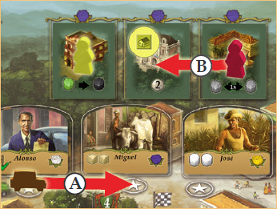 |
Example:
A) Martina goes by car to “Miguel“ and gets 2 wood
from the supply.
B) Afterward, she must move her red playing
piece to a building that lies beneath a blue rose.
Since the cigar factory is already occupied by Philipp’s
yellow playing piece and Martina is not allowed to
remain on the black market, she must move her
playing piece to the bank. She then uses the bank and
gets 2 pesos. Since the bank is owned by Philipp, he
now receives 1 victory point from the supply. |
The buildings
 |
Bank
You immediately get 2 pesos from the supply. |
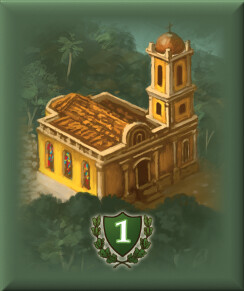 |
Church
You immediately get 1 victory point from the supply. |
 |
Distillery
You may immediately trade any amount of sugar cane into the supply in exchange for the same amount of rum. |
 |
Cigar factory
You may immediately trade any amount of tobacco into the supply in exchange for the same amount of cigars. |
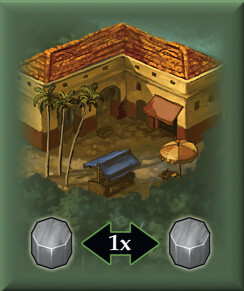 |
Black market
You may immediately trade 1 of any good into the supply in exchange for 1 of any other good. (Wood may not be traded). |
 |
Sawmill
You may immediately trade 1 wood into the supply in exchange for 1 victory point and 1 peso. |
 |
Café
You may immediately return 1 cigar and/or 1 rum to the supply. For each good you get 2 victory points.
(So you can receive up to 4 points when you return 1 cigar and 1 rum to the supply, but you are not
allowed to give up more than 1 good of either kind.) |
|
 |
Customs office
You may immediately turn one die of your choice on the ship to its “0“ side. |
 |
Casino
You may immediately convert any number of pesos into victory points, or vice versa.
For every 3 pesos you get 1 victory point.
For each victory point you give up, you get 3 pesos from the supply. |
 |
Harbormaster’s office
You may move the value marker either one flag to the right or one flag to the left.
Thus, the amount of victory points per delivered good increases or decreases.
If you move the value marker to the checkered flag, then the ship immediately leaves port and a new ship comes in (see “A new ship“).
If the value marker is already on the leftmost flag with the “2“, then it can only move to the right. |
 |
Office
You may immediately deliver 1 good that is in demand on the ship. You receive exactly 2 victory points
(regardless of which flag the value marker is on). You may not deliver wood.
Subsequently,
adjust the demand by reducing the corresponding die value by 1. |
 |
Newspaper publisher
You immediately get 1 peso.
You may also flip one Cuban tile of your choice over and thus render it inactive.
On a later turn, the car may be moved to this Cuban, but neither the Cuban nor the function of a building may be used.
However, the inactive Cuban's “star“ space may be skipped with the car according to the usual
rules by paying the appropriate costs.
Once the car has passed the inactive Cuban,
flip the tile back over to its front side again. |
|
A new ship
A ship immediately leaves port when:
1. its demand is fully met (all dice show a “0“) OR
2. the value marker is moved to the checkered flag.
| A new ship then comes into port. Therefore, move the
ship token 1 space to the right on the ship's bar. |
 |
| Each time a new ship comes into port, the value marker is
automatically moved to the flag with the “2”. |
 |
The demand of the new ship is determined by the player who caused the previous ship to leave.
Depending on the situation, this may be the player who:
1. moved the car to the port and triggered a delivery round.
2. made the value marker move to the checkered flag by skipping the port with the car or by
using the Harbormaster’s office.
3. neutralized the final demand of the ship by using the Customs office.
4. met the final demand by using the Office.
The player determines the new demand at the end of his turn by taking the 5 dice and rolling
them. Then he chooses 4 of the 5 dice and places them, as they were rolled onto the 4 die spaces
of the large ship. The remaining die (this good will not be in demand) is put next to the game
board.
End of the game
The game ends immediately after the departure of the 7th ship.
Each player removes his screen and may convert his remaining goods (including wood) into
victory points: Players get 1 victory point for every 3 goods of any kind they return to the
supply. Money is not worth any victory points. Players now count their victory point markers.
Whoever collected the most victory points is the winner of the game.
In the case of a tie, the winner is the tied player who still has the most goods left.
If there is still a tie, the winner is the tied player who has the most money left.
Santiago de Cuba
Author: Michael Rieneck
Illustrations: Michael Menzel
Rule book and layout: Alfred Viktor Schulz
Rule book revision: Patrick Koner
Copyright: © 2011 eggertspiele GmbH & Co. KG,
Fiedhofstr.17, 21073 Hamburg
All Rights reserved.
www.eggertspiele.de
Distribution:
Pegasus Spiele GmbH
Straßheimer Str.2,
61169 Friedberg
www.pegasus.de